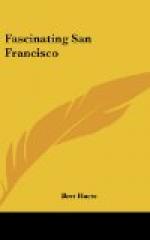San Francisco shows a market as complete and original in styles as any city in the country. The excessive seasonal changes demanded in the East are not needed here. San Francisco is essentially an out-of-door city, with three hundred odd days of clement weather, made for the display of light raiment, whether it be organdie dresses, sports togs or afternoon frocks. Women of the city insist on being modish, however, so they wear furs with the airiest of apparel on the warmest days, contradictory but vivacious apparitions. Even the Chinese girls ape their Western sisters and appear in brocaded mandarins with fur neck pieces.
The dash of San Francisco women on the street, as well as in the hotels and cafes, is not a legend. You may read about it in Hergesheimer’s iridescent detail, but seeing is believing.
The art shops and the book shops of San Francisco evoke the admiration of every visitor. The art shops, on Post, Sutter and adjacent streets, close to Union Square, with their own galleries of paintings, bronzes and marbles, have showrooms that are more like museums than commercial establishments. The book shops are in this same neighborhood. They are well worth visiting, several of the dealers being publishers of the works of California authors.
Chinatown and Foreign Colonies
From its beginning as a Spanish trading post to the present time there has always been something essentially foreign about San Francisco. Always there have been foreign elements, with well-marked colonies, districts or haunts.
To visitors Chinatown appears to exercise the greatest appeal among the foreign colonies. The Latin Quarter, the Spanish and Mexican districts out toward the end of Powell street at the Bay, the Japanese streets east of Fillmore, and the Greek settlement centering around Third and Folsom are all, however, highly expressive of their habitants.
With its pagoda-like roofs, its bazaars, its restaurants of amazing orchestration and stranger East-West decoration, it is easy to. understand why Chinatown sways the imagination of wayfarers in San Francisco. Every street and alley in it is obviously exotic. Life appears here like a festival, and both the eye and the ear are beguiled by fantastic nuances.
Silks, ivories, porcelains and bronzes peer from the shop windows at hesitant purchasers like the articles of virtu flung before the bewildered gaze of readers by Balzac in his Wild Ass’s Skin.
You are diverted by the bizarre on all sides, Grant avenue, the main artery of Chinatown, stretching before you in a many-hued arabesque of shop fronts, no two quite alike in tone or in the stuff they have to sell.




